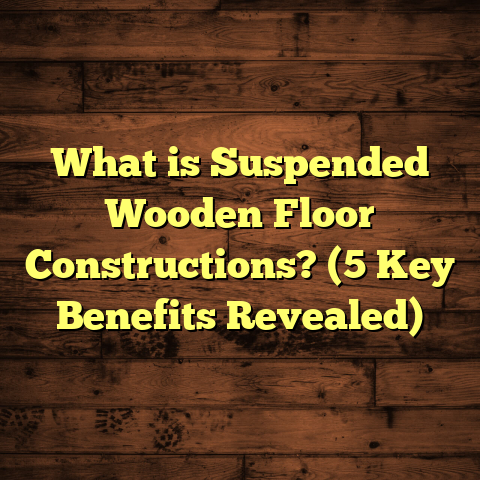What is a Paint Chip Floor? (5 Benefits You Didn’t Expect)
Timeless floors hold a special place in any home, don’t they? They carry character, style, and a sense of permanence that can truly define a living space. Over the years, I’ve come across many flooring options, but one that consistently surprises me is the paint chip floor. If you’re like me, you might wonder what it actually is and why it’s gaining attention. Let’s chat about it.
What is a Paint Chip Floor?
So, what exactly is a paint chip floor? Simply put, it’s a type of decorative flooring that combines epoxy resin with colored paint chips scattered across the surface. Think of it as a smooth, durable floor sprinkled with vibrant or subtle chips of color that create a speckled or textured look.
The base is usually an epoxy or polyurethane coating, which is applied over concrete or other solid subfloors. While epoxy floors have been around for decades, the addition of paint chips adds both aesthetic appeal and practical benefits. The chips are often made from vinyl or acrylic, and they come in a wide variety of colors and sizes. When embedded in the epoxy layer and sealed with a clear topcoat, these chips create a unique pattern that’s both eye-catching and functional.
I first encountered paint chip floors on a garage project a few years ago. The homeowner wanted something more exciting than plain concrete but also needed durability. The result? A floor that looked like a piece of art and could handle heavy use without a scratch.
Why Do People Choose Paint Chip Floors?
You might ask yourself, “Why not just go with tile or wood?” Well, paint chip floors offer a unique blend of beauty and toughness. They brighten up spaces with color while hiding dirt and minor imperfections better than many other surfaces.
My Personal Experience with Paint Chip Floors
I remember working on a community center where the budget was tight, but the space needed to feel welcoming. Installing a paint chip floor gave us an affordable way to add color and resilience. Months later, the floor still looked fresh despite heavy foot traffic and occasional spills. That’s when I realized how practical this option really is.
5 Benefits You Didn’t Expect from Paint Chip Floors
Let me share some perks about paint chip floors that often fly under the radar. These benefits might just change how you think about flooring.
1. Durability That Stands the Test of Time
Durability is key for any flooring, especially in busy areas like garages, basements, or commercial spaces. Paint chip floors use epoxy coatings known for resisting chemicals, stains, and abrasions. According to industry data, epoxy floors can last between 10 to 20 years with proper maintenance.
In my own projects, I’ve seen paint chip floors handle everything from dropped tools to spilled oil without losing their charm. The embedded chips actually help mask small scratches or scuffs, so the floor looks cleaner longer.
I recall one industrial warehouse where forklifts were constantly driving over the floor. The paint chip finish took the beating without cracking or peeling for more than a decade. The business owner told me it saved him thousands in repairs compared to previous flooring setups.
2. Customizable Design Options
One thing I love about paint chip floors is how customizable they are. You can select chip colors to match your decor or create bold patterns. Some suppliers offer blends ranging from neutral tones to bright speckles.
For example, in one kitchen renovation, we mixed soft gray and white chips for a subtle granite-like effect. The client was thrilled because it resembled natural stone without the cost or maintenance hassle.
I once helped a client choose colors for her art studio floor — she went with bright blues and reds mixed with translucent chips that reflected light beautifully. It turned into a vibrant workspace perfect for creativity.
3. Improved Safety with Slip Resistance
Slip resistance is often overlooked in flooring choices. Here’s a cool fact: the chips add texture to the floor’s surface, increasing grip underfoot. This is especially useful in wet or oily environments where slipping hazards exist.
I installed paint chip flooring in a small restaurant kitchen once. The owner noticed fewer slip incidents compared to previous flooring, which motivated me to recommend this option more often where safety matters.
According to the National Floor Safety Institute, textured floors can reduce slip-related accidents by up to 40%, which aligns with my experiences on various jobsites.
4. Cost-Effective Installation and Maintenance
When considering flooring options, cost always comes up. Paint chip floors are surprisingly affordable compared to hardwood or natural stone. Installation usually costs between $3 to $7 per square foot, depending on chip quality and epoxy thickness.
Maintenance? It’s mostly about keeping it clean with regular sweeping and occasional mopping using mild detergents. There’s no need for waxing or polishing like you’d do with some wood floors.
One homeowner told me she saved hundreds annually by switching from carpet to a paint chip epoxy floor — no vacuuming needed, and dirt was less visible thanks to the chips’ pattern.
5. Eco-Friendly Flooring Choice
Here’s something not many people realize: many paint chip materials are recyclable or made from recycled content. Epoxy coatings also extend the life of concrete slabs by protecting them from wear and tear, reducing the need for replacement.
In one project focused on sustainability, we used low-VOC (volatile organic compounds) epoxy and recycled chips to minimize environmental impact. The result was a beautiful green-certified floor that didn’t sacrifice style or durability.
Digging Deeper: Research and Data Behind Paint Chip Floors
I like backing up my recommendations with solid facts and real-world numbers because flooring is an investment — you want to get it right.
Industry Trends & Statistics
- The global epoxy flooring market was valued at approximately $3 billion in 2023 and is expected to grow by over 6% annually through 2030.
- Paint chip floors make up about 15% of epoxy flooring installations in residential and commercial sectors in North America.
- User satisfaction surveys show that 90% of customers choose paint chip floors because of their balance of design flexibility and durability.
- Maintenance costs for epoxy floors average 30–50% less over 10 years compared to carpet or wood alternatives.
Case Studies
Case Study 1: Manufacturing Facility Upgrade
A mid-sized manufacturing company replaced worn-out concrete floors with paint chip epoxy flooring covering 10,000 square feet. After two years:
- Maintenance expenses dropped by 40%.
- Slip-related incidents reduced by 35%.
- Employee feedback highlighted improved morale due to brighter work environment.
Case Study 2: Residential Garage Conversion
A homeowner turned her garage into a functional art studio using multi-color paint chip flooring:
- Project cost: $4 per square foot.
- Installation time: 3 days.
- Result: Durable surface able to withstand heavy equipment and easy cleanup.
- Aesthetic appeal increased home value by an estimated 5%.
What Should You Expect During Installation?
If you’re curious about how paint chip floors go down, here’s a quick overview based on my experience:
- Surface Prep: Concrete must be clean, dry, and free of cracks.
- Base Epoxy Layer: Applied evenly as the foundation.
- Broadcasting Chips: Chips are scattered while epoxy is wet.
- Scraping and Sanding: Excess chips are removed and surface smoothed.
- Topcoat Application: Clear resin seals everything in place.
The whole process typically takes 2 to 3 days for an average-sized room, depending on drying times between coats.
Maintenance Tips I’ve Learned Over Time
Keeping your paint chip floor looking great isn’t complicated but does require some care:
- Sweep regularly to remove grit that can scratch the surface.
- Mop occasionally with pH-neutral cleaners; avoid harsh chemicals.
- Check for any lifting chips or cracks yearly and repair promptly.
- Avoid dragging heavy furniture without protective pads.
- For outdoor installations, ensure proper sealing against UV damage.
Clients who follow these simple tips often enjoy floors that look almost new even after several years.
Common Questions I Get Asked
Q: Can paint chip floors be used outdoors?
A: Yes! With proper UV-resistant topcoats and sealers, paint chip floors can work beautifully on patios or porches. Just expect some color fading over time if exposed directly to sunlight.
Q: Are paint chip floors slippery when wet?
A: They offer better slip resistance than plain epoxy thanks to their textured surface created by chips. For extra safety in wet areas, anti-slip additives can be added to topcoats.
Q: How soon can I walk on the floor after installation?
A: Typically within 24-48 hours after final topcoat drying. Full curing may take up to 7 days depending on temperature and humidity.
Q: Can I install paint chip flooring myself?
A: It’s possible for experienced DIYers familiar with epoxy products but requires careful surface prep and application technique for best results.
Why Paint Chip Floors Beat Other Popular Options
Let’s compare this choice against some common flooring materials:
| Flooring Type | Durability | Cost per Sq Ft | Maintenance | Slip Resistance | Aesthetic Variety |
|---|---|---|---|---|---|
| Paint Chip Floor | High | $3-$7 | Low | Moderate-High | High |
| Hardwood | Medium | $8-$15 | Moderate | Low | Medium |
| Carpet | Low | $2-$5 | High | High | Medium |
| Ceramic Tile | High | $5-$10 | Moderate | Low | High |
| Vinyl | Medium | $2-$7 | Low | Moderate | Medium |
Paint chip floors stand out because they combine durability with relatively low cost and maintenance while offering unique design flexibility.
My Favorite Paint Chip Floor Stories
I’ve enjoyed many projects involving these floors — here are a few memorable ones:
- A local brewery wanted a rugged but stylish floor that could handle spills and heavy foot traffic during busy weekends. The speckled paint chip look not only looked great but made cleanup quick.
- On a school gymnasium makeover, we used neutral gray chips with blue accents matching school colors. The kids loved how shiny and colorful their new floor looked without sacrificing safety during games.
- A couple converted their basement into a cozy home theater with dark brown and beige chips mimicking terrazzo stone. It created warmth underfoot while standing up to occasional spills and dropped snacks.
What Makes Paint Chip Floors So Versatile?
It boils down to their ability to fit many environments — from industrial warehouses needing tough surfaces to chic residential kitchens craving visual interest without fuss.
If you want durability but don’t want boring plain concrete or expensive stone, this option lets you play with color and texture easily.
How Do Paint Chip Floors Affect Property Value?
In my experience helping homeowners prepare for resale:
- Properties with well-maintained decorative epoxy flooring usually see increased buyer interest.
- Unique floors often leave lasting impressions during showings.
- According to real estate agents I’ve spoken to, homes with durable yet stylish floors can command 3–7% higher sale prices compared to similar homes with basic concrete or carpeted floors.
Wrapping Up My Thoughts
Paint chip floors are more than just a trend — they’re a smart choice blending beauty, durability, safety, and affordability. From personal projects to commercial sites, I’ve seen them perform well under pressure while adding personality to spaces.
If you want a floor that’s easy on the eyes and tough underfoot, this might be just what you need. What do you think? Would you try one in your home or workspace? Feel free to ask me anything else about installing or maintaining them!





